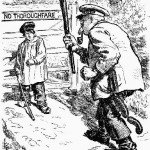
The Schlieffen Plan was a battle plan, drawn up by German tacticians, to secure victory against both France and Russia. From the 1870s, German military tacticians mused over a particular strategic concern: if Germany ever found itself at war with both France and Russia, she would be surrounded and forced to fight on two fronts, dividing her resources and doubling the risk. A better strategy was to knock out one of her antagonists quickly, then deal with the other – but this was easier said than done. The French had constructed a chain of forts, defences and concrete pillboxes (machine-gun nests) along their eastern border with Germany. These fortifications made an invasion of France a difficult prospect; any assault on French territory would be held up, would take weeks to penetrate and would probably involve significant losses.
The Germans embraced a workaround to this impasse called the Schlieffen Plan. It was named for its inventor, Count von Schlieffen, who constructed the plan in 1905 after studying the Russian military’s performance in its ill-fated war with Japan (1904-5). Schlieffen noted that Russia was enormous but lacked railways; any full mobilisation of its forces would take several weeks, perhaps as long as three or four months. He set his sights on finding a way to invade France, capture Paris and force a French surrender quickly, ideally within two months; after this Germany could turn its full attention to Russia. Schlieffen’s battle plan involved some German troops entering France through its more lightly-defended northern borders – but most would instead invade via the small nations of Belgium, Luxembourg and the Netherlands. These three nations were neutral, lacked sizeable military forces and had borders with France that were largely unprotected. Once into northern France, four waves of German troops would sweep south-west and down toward Paris. Since most French troops would be positioned on the German border, they could be outflanked and surrounded. Schlieffen and his planners predicted victory could be achieved in as little as 40 days.
“Demands imposed on men and animals, the requirement for perfect co-ordination over long distances and the difficulty of dislodging entrenched opponents all suggest that the plan could never have succeeded. Schlieffen’s plan was a brilliant strategy but designed for an era when armies numbered in tens of thousands, not in the hundreds of thousands and millions. Still, the details of planning seem to have provided the basis for a pervasive confidence that they could win the war that they believe would happen, and that they could win it quickly.”
Frank B. Tipton, historian
It was a bold and daring strategy that reflected Schlieffen’s philosophy: “To win, we must be the stronger of the two at the point of impact. Our only hope of this lies in making our own choice of operations, not in waiting passively for whatever the enemy chooses to do.” But not all in the German high command supported his plan. Some thought it risky, provocative and wasteful of men and resources. Schlieffen’s replacement, General von Moltke, was of this view. When he took command in 1906 he downsized the Schlieffen strategy, reducing troop numbers and removing the Netherlands from the battle plan. In August 1914 German troops entered Belgium as per von Moltke’s modified plan, catching the small Belgian contingent by surprise. But it was in Belgium that the strategy began to unravel. Belgian military forces, supported by civilian militia, held up the Germans for almost four weeks – double the anticipated time. The attack on neutral Belgium also drew England, a guarantor of Belgian neutrality, into the war. Belgium also provided a ripe source of Allied propaganda about callous German disregard for neutrality, as well as alleged German brutalities against Belgian civilians, women and children.

In military terms the Schlieffen Plan was partially successful, in that it allowed some rapid penetration into France. But the nature of this advance created its own problems. The speed of the German advance placed great strain on its troops, most of whom were travelling on foot. Within a month German divisions had reached the Marne River, to the immediate north-east of Paris – but they were fatigued, battle-weary from marching, plus many small but frequent engagements along the way. There was also considerable strain on long German supply lines (the routes by which an advancing army receives its food, munitions, reinforcements and other needs). The Schlieffen Plan also under-estimated the military, infrastructure and capacity for mobilisation of both France and Russia. On the Eastern Front, the Russians were able to launch an offensive against Germany faster than anticipated. The French also organised and moved their own troops rapidly. Several hundred Paris taxis were even commandeered by the military and used to ferry thousands of troops to defensive positions. The German advance was ultimately halted at the week-long Battle of the Marne (September 1914); their inability to advance further became a major factor in the development of trench warfare and the Western Front.

1. The Schlieffen Plan was Germany’s tactical solution for avoiding a two-front war with France and Russia.
2. Under this plan, drawn up in 1905, France would be forced to a quick surrender by a German invasion in the north.
3. German forces would move through neutral nations like Belgium and Luxembourg, bypassing French fortifications.
4. Schlieffen’s initial plan, modified by General von Moltke, became the accepted strategy in the event of a European war.
5. The plan allowed the Germans to penetrate French territory quickly and with relatively few losses, however the speed and logistics of the advance meant that it could not be sustained, allowing the French to quickly mount a response.
© Alpha History 2014. Content on this page may not be republished or distributed without permission. For more information please refer to our Terms of Use.
This page was written by Jennifer Llewellyn, Jim Southey and Steve Thompson. To reference this page, use the following citation:
J. Llewellyn et al, “The Schlieffen Plan” at Alpha History, https://alphahistory.com/worldwar1/schlieffen-plan/, 2014, accessed [date of last access].
